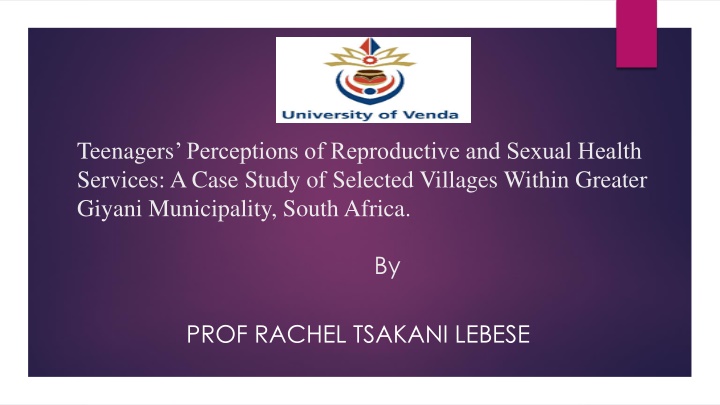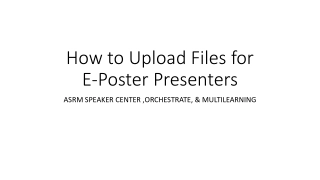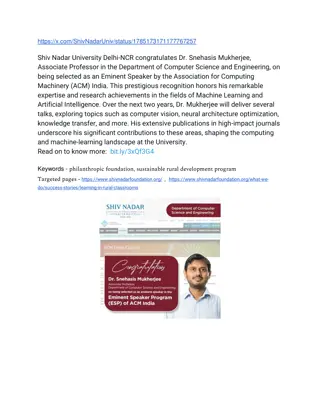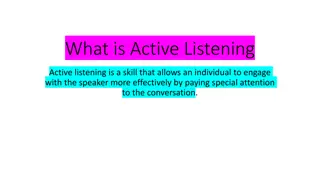Teenagers Perceptions of Reproductive and Sexual Health Services in Greater Giyani Municipality, South Africa
This case study explores teenagers' perceptions of reproductive and sexual health services in selected villages within Greater Giyani Municipality, South Africa. The study highlights the importance of comprehensive sexual and reproductive health care, including family planning, STI prevention, and healthy sexuality promotion. Methodology involved purposive sampling of teenagers aged 10-19, data collection through interviews and observations, aiming to understand and address the reproductive health needs of adolescents in the region.
Uploaded on Dec 07, 2024 | 0 Views
Download Presentation

Please find below an Image/Link to download the presentation.
The content on the website is provided AS IS for your information and personal use only. It may not be sold, licensed, or shared on other websites without obtaining consent from the author.If you encounter any issues during the download, it is possible that the publisher has removed the file from their server.
You are allowed to download the files provided on this website for personal or commercial use, subject to the condition that they are used lawfully. All files are the property of their respective owners.
The content on the website is provided AS IS for your information and personal use only. It may not be sold, licensed, or shared on other websites without obtaining consent from the author.
E N D
Presentation Transcript
Teenagers Perceptions of Reproductive and Sexual Health Services: A Case Study of Selected Villages Within Greater Giyani Municipality, South Africa. By PROF RACHEL TSAKANI LEBESE
Introduction The five core components of sexual and reproductive health (SRH) care are: improvement of antenatal, perinatal, postpartum, and newborn care; provision of high-quality services for family planning, including infertility services; elimination of unsafe abortions; prevention and treatment of sexually transmitted infections (STI), including human immunodeficiency virus (HIV); reproductive tract infections, cervical cancer, and other gynaecological morbidities; promotion of healthy sexuality. In 1994, delegates from the governments of 179 countries and more than 1200 non- governmental organizations (NGO) met in Cairo at the International Conference on Population and Development (ICPD) and agreed on a 20-year programme of action to improve sexual and reproductive health, foster reproductive rights, and stabilize the world s population. 180 countries pledged support for the provision of comprehensive SRHS delivered through integrated systems rather than through separate vertical programs (WHOa, 2004). SA has since 1994 put in place significant intervention mechanisms within SRH and well-being are essential, if teenagers are to have responsible, safe and satisfying sexual lives. Over the past ten years there has been much change in the understanding of human sexuality and sexual behaviour (Sharon et al., 1998).
Population and Sampling The population- all the teenagers, ages of 10-19 years. The non-probability purposive sampling approach (also known as judgmental sampling technique) SAMPLING- Sampling of District, Villages, schools and Sampling of participants. Teenagers in Mopani District living in HLANEKI and NWAMAKENA villages were the participants they were selected because of high teenage pregnancy as it was reported on news in 2011, they were interviewed until data saturation was reached. The inclusion criteria was teenagers of both genders, aging between 10-19 years old living in NWAMAKENA or HLANEKI village. Consent was obtained from parents, for the participants younger than 16 years.
Data collection Data unstructured interviews, field notes and observation notes were taken. Audio tapes were used as it helped the researcher by recording participant s voices and it also helped in ensuring that the researcher got correct information as this was cross checked with field notes and observational notes. Researcher collected data with the assistance of language expert and translation were from English to Tsonga. was collected through focus group using
Data Analysis Tech s eight steps of open-coding were used to analyze the qualitative data in this study (Creswell 2009). Themes and sub-themes emerged
Trustworthiness Trustworthiness was ensured through the following: credibility, transferability, dependability and conformability.
Ethical Considerations Permission to conduct a study Permission to conduct the study was obtained from the following authorities; UNIVEN Department of Advanced Nursing Science Committee, UNIVEN School of Health Sciences Committee, Higher Degrees Committee of the University of Venda, Ethics Committee of the University of Venda, Chiefs of the villages in Mopani District where this study was conducted and from the participants through informed consent.
Table 4.3: Main themes, themes and sub-themes that emerged from the data analysis Results Main Themes Factors leading to teenage pregnancy Themes 1.1 Personal factors leading to teenage pregnancy Sub-Themes 1.1.1 1. Lack of parental supervision and support 1.1.2 Peer pressure a contributory factor Ignorance towards parental guidance Provision of state child support grant for teen mothers and poverty Sexual intercourse preferences 1.1.3 1.1.4 1.1.5 1.1.6 Teenagers perceptions and knowledge on contraceptives and condom use Negative attitude towards 1.1.7
Results Main Themes Themes Sub-Themes 1.2 Institutional factors leading to teenage pregnancy 1.2.1 Negative attitudes of nurses towards teenagers at the clinic 1.2.2 Insufficient information on SRHS in the community, schools and clinic 1.2.3 Long waiting hours blamed for teenage pregnancy 1.2.4 Lack of privacy at the clinic
Results Main Themes Themes Sub-Themes 1.3 Cultural factors leading to teenage pregnancy 1.3.1 Cultural taboos related to discussion of SRH issues Cultural bridal inheritance Poor teaching at home Need to have a child Availability of indigenous abortion practices 1.3.2 1.3.3 1.3.4 1.3.5 2. Positive perception about SRHS 2.1 Knowledge of the available SRHS
Discussion Main Theme 1: Factors Leading to Teenage Pregnancy The study found that in both villages there was poor utilization of SRHS by teenagers and it was due to their negative perceptions towards SRHS. Most teenagers mentioned that they would only visit the clinic when they were sick, but not for SRHS. For abortion services the teenagers preferred consulting traditional healers who they called Inyanga and Sangomas. The participants expressed their frustration, especially when they tried to go to the clinic for SRHS, and most of them were not happy with nurses attitudes. One of the teenagers offered the following as a reason to why they end up going to the clinic or hospital: Some they are not clean inside and they become infected after aborting with herbs or stamata and cokes, that s when they run to the clinic or hospital to get help. (Female, 17 years old, dropped out participant no. 17).
Discussion Theme 1.1: Personal Factors Leading to Teenage Pregnancy Most teenagers insisted that lack of parental supervision, peer pressure, ignorance among teenagers, need of child grant/poverty is the most reason of engaging in unsafe sex practice. Negative attitude towards HIV/AIDs were the main personal factors that hindered them from accessing and using SRHS. Sub-Theme 1.1.1: Lack of Parental Supervision and Support. Teenagers felt that some parents did not care to know where their children went, hence giving them the freedom to go to the bottle stores and men will buy alcohol for them and then sleep with them when they are drunk. Participants said: Sometimes parents leave their children at home alone and then they take advantage of that and they sleep around then they fell pregnant they won t even know who is the father of the child. (Male, 19 years old, grade 12, participant no. 2).
Discussion Sub-Theme 1.1.2: Peer Pressure a Contributory Factor. Some of the participants said; Teenagers we like fashion, if my friend has a Cavela and they can t afford it at my home I will have to get a boyfriend with money so that he can buy for me Cavela. (Female, 19 years old, grade 11, participant no. 17) Sub-Theme 1.1.3: Ignorance Towards Parents Guidance A participant said: Most of teenagers become pregnant because they don t listen to their parents.. (Male, 19 years old, grade 12, participant no. 6) Sub-Theme 1.1.4: Provision of State Child Support Grant for Teenage Mothers and Poverty Teenagers articulated: Is just that teenagers they want money, child s grant that is why they have sex. You find that they don t have money at home, so they think it is important for them to have sex so that they can fall pregnant and get child s grant to take care of themselves. (Female, 16 years old, grade 8, participant no. 18).
Discussion Sub-Theme 1.1.5: Sexual Intercourse Preferences. Teenagers preferred having sexual intercourse without condom. Thus, they did not perceive that such practices put them at risk of getting HIV/AIDS and other STI. Participants said, Idon t know, but condoms I see them as for me I use them to hold socks when going to school, I am serious. (Male, 18 years old, grade 11, participant no. 10) Sub-Theme 1.1.6: Negative Attitude Towards HIV/AIDS and STI. Most teenagers expressed that HIV is not a threat to them and that they are more scared of pregnancy than HIV and STI. Teenagers responded: Theydon t care about HIV they take it as something small, like cough and flu. They take it for granted, like cough they tell themselves that these days everyone has HIV. You find that if you are not HIV-positive in future they will laugh at you. (Female, 16 years old, dropped out of school, participant no. 18)
Discussion Theme 1.2: Institutional Factors Leading to Teenage Pregnancy. Institutional factors such as negative attitudes of nurses, insufficient information on SRHS, long queues and separate queues for different services, and lack of privacy contributed to teenagers poor utilization of SRHS. Participants said, Many people, more especially girls, when they come to the clinic when they want to prevent they say that nurses are telling them that they should first test for HIV/AIDS, then many people are afraid to be tested HIV. That is why many people go back and no longer preventing. (Male, 19 years old, grade 12, participant no. 2). Sub-Theme 1.2.1: Long Waiting Hours Blamed for Teenage Pregnancy. I have to queue and at home they will be looking for me because they sent me to spaza. So they will look for me and others that were at the clinic will say I saw her at the clinic and they will come for me at the clinic and when they get there they will beat me, so I will end up not collecting the morning after pill. (Female, 19 years old, dropped out of school, participant no. 6).
Discussion Theme 1.2.2: Lack of Privacy at the Clinic. Participant said; If you come to the clinic and you want to do abortion the nurses here they gossip a lot they don t keep secret that is why the teenagers are afraid to come to the clinic because when they come to do something nurses gossip that they are young and already have a boyfriend and that they even come for contraceptives. They even gossip at their homes in the village they don t have heart to keep secret and there is no privacy. (Male, 18 years old, grade 11, participant no. 3). Sub-Theme 1.3.1: Cultural Taboos Related to Discussion of Sexual and Reproductive Health Issues. Culture contributed to teenagers non-utilization of SRHS because very few participants indicated that their parents talked to them about sexual matters. Sub-Theme 1.3.2: Poor Teaching at Home One of the participant said; Some is they are being influenced by their parents, parents sometimes you find that I stay with my mother and without a father and my mother will say ok my child life is like this, if you go and get sugar daddies they will give that we can be able to live. Old sugar daddies are wise he will not allow me to come and fool him by asking him to use condom. (Female, 16 years old, grade 8. participant no. 18)
Discussion Sub-Theme 1.3.3: Availability of Indigenous Abortion Practices. Most of the teenagers said they preferred the Inyanga and Sangoma as they are easy to access, keep their information private and they did not have to queue. Participants said, Some go to abort babies to people who are not doctors or not trained even, they go to illegal doctors and some are advised by their friends to boil coke and drink or spirit then it will come out because I also did it and it worked. (Female, 14 years old, grade 9, participant no. 14). For abortion some prefer to go to Giyani because there are many doctors who know how to abort and they are cheap; some boil coke and drink some drink spirit some go to Sangoma and some go to clinic, but majority they go to Sangoma (Female, 16 years old, dropped out of school, participant number 13)
Discussion Main Theme 2: Positive Perception About SRHS Teenagers who participated in this study had positive perceptions about SRHS as they at least knew the SRHS which are offered at the clinics and even at the hospital. They had knowledge on the available SRHS at clinic. participant said; At school when we learn Life Orientation they teach us, many people don t listen. They take things for granted. So they do their own things and also we learn from Love Life. (Female, 17 years old, dropped out of school, participant no. 26).
Conclusion. Non-utilization of SRHS among the teenagers is the main cause of most teenagers not being able to meet their ideals in life as most of them end up with teenage pregnancy. An important cornerstone of solving the problem of teenagers not utilizing SRHS is through health education and promotion at clinics, their communities and at schools. Parents also have a major role to play by accepting that their children are no longer just children, but some start sexual activities at a very young age, hence they need to be open and talk to them about sexual matters as some will take the parents information more serious than when they hear it from other people. Most teenagers feel shy and scared to go to the clinics for SRHS, hence there is a need for ensuring that health caregivers change their attitudes towards teenagers who come for SRHS.
THE END THANK YOU. KHANIMAMBO























